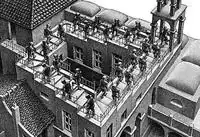(Pun definitely intended.)
Dear MSE-Community,
If I were to choose one artist that has made interesting works of art not only because of their beauty but also because of their connections to Mathematics, I would choose Escher. His works have always intrigued me. Some of his paintings are mind-boggling when looked at for a long time, but I have the feeling that it can be described accurately with mathematics.
Let's compare some drawings. In the first and second drawing ((1),(2)), the artist chooses to depict some simple geometrical objects in one- and two point perspective respectively. Although the objects seem to float in space, both the images look "all right" to me. These drawing are, however, though not 'Eschers', illusory too. The brain somehow creates 3D space from 2D space, but that's more of a biological issue.
One Point Perspective
 (1)
(1)
Two Point Perspective
 (2)
(2)
Sub-question 1: How does one describe these seemingly "sound" drawings mathematically? How do (1) and (2) compare to one another?
Now, lets get to to part I find most interesting, Escher's etchings, prints and lithographs. When I look at the following pictures:
-- M.C. Escher 1960 lithograph Ascending and Descending
 (3)
(3)
-- M.C. Escher 1953 Relativity
 (4)
(4)
I recognize that these are two different types of paradoxes because Escher plays with perspective in two different ways.
Sub-question 2: How could the difference between these and other visual paradoxes of artists (mostly Escher, but I guess there are a lot more artists that mimic and extend his style) be formalized with the aid of mathematics?
Thanks,
Max Muller
P.S. I'm sorry these images are all of different sizes and some are too large. I'm a bit in a hurry so I didn't make them equally large.